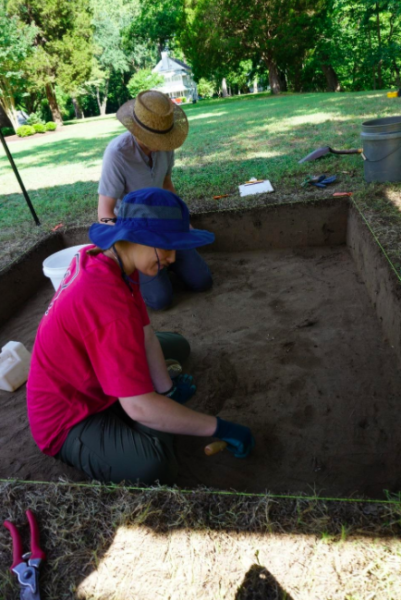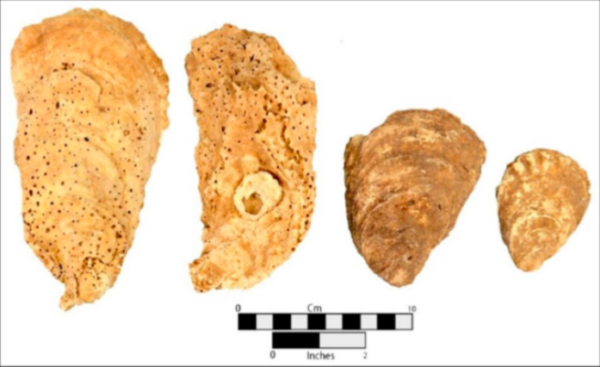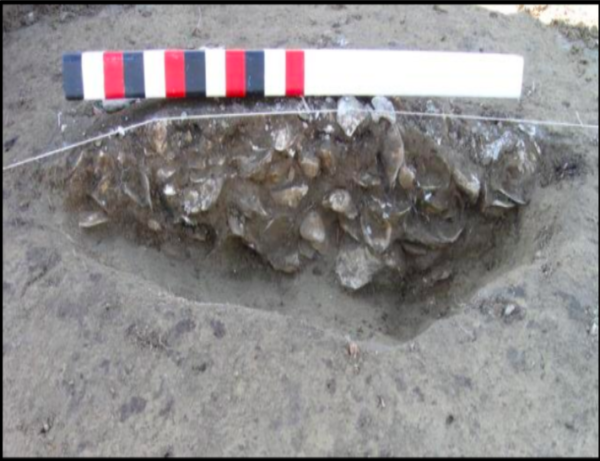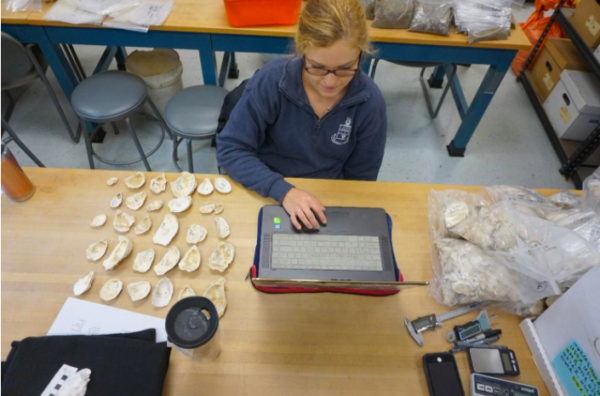The World is Your Oyster: The Historical Sustainability of the Chesapeake Oyster Fishery
By Mary Lawrence Young ’21
When I first began school at William & Mary, I never imagined I would have the opportunity to conduct my own independent research, let alone have my research published in a local journal. However, over the past year, I have worked with faculty members from various departments to develop an Honors Thesis that integrates not only my majors—Anthropology and Environmental Science—but also my academic interests. My honors thesis explores the historical sustainability of the Chesapeake Bay oyster fishery leading up to the oyster population collapses seen at the onset of colonization. The Chesapeake Bay has a historic record that spans from as early as the Paleoindian period (B.C. 12,000-10,000) through the 20th Century. It served as the primary estuarine resource in the mid-Atlantic for Native Americans for millennia due to its rich abundance of natural resources. Prior to colonization, Native Americans made widespread use of the Bay, today found in the form of archaeologically uncovered shell middens (trash pits) typically dominated by the eastern oyster (Crassostrea virginica).
For millennia, Native Americans in the Chesapeake Bay harvested oysters sustainably, allowing the precontact oyster fishery to remain resilient largely due to Native harvesting practices centered on oysters collected from shallow water, nearshore reefs. As a keystone species, oysters and their reefs provide vital ecological services necessary for the survival of many other species in the Bay. However, there has been an estimated 85% loss in oyster reef abundance from historical records since the onset of colonization. European colonization brought a whole new flock of people into the tidewater region, significantly increasing the demand for the, once abundant, oyster reefs. By the mid to late 1800s, 400 to 600 thousand oysters were being harvested from the Bay annually, quickly depleting resources; harvests decreased by as much as 50% by the early 1900s and by 98% by the early 1990s. Throughout the past 400 to 500 years, Anthropogenic habitat modifications to the Chesapeake Bay, such as overharvesting, have fundamentally changed the ecosystem of the Bay and killed off many oysters.
In my research, I seek to understand how Native Americans harvested oysters sustainably over thousands of years, and how the oyster fishery remained resilient under their care. My specific questions center around how oyster harvesting practices changed over time, and how those changes could have played a part in the degradation of the oyster fishery. During the summer and fall of 2019, and this fall, I analyzed over 3000 archaeologically recovered oyster shells from a series of roasting pit features from an archaeological site located along the York River in York County.

My archaeological field school partner and I beginning the excavation of a roasting pit during the summer 2019 field season.
At this point, I have measured approximately 1000 oysters from three different occupational periods at the site: Archaic Period (8000 BC– 1200 BC), Middle Woodland Period (500 BC – 900 AD), and Post-Contact Period (1600 and on). I plan to use the data collected from the shells to explore two different elements that I believe contributed to the sustainability of the Native American oyster fishery. First, the location in which the oysters are being harvested – either nearshore or offshore. This can be determined by measuring six attributes for each left shell:
- height (i.e. measurement of the shell from the dorsal to the ventral),
- length (i.e. measurement from anterior to posterior),
- height to length ratio or HLR (i.e. height of oyster divided by length),
- presence, absence, and type of attachment scars,
- presence or absence of sponge parasitism, and
- left valve concavity (i.e. “cuppyness” of a dip in the shell).
Generally, the nearshore oysters were smaller, rounder, and had little to no parasitism on the shells, while the offshore oysters were longer, more deeply cupped, and had a much greater percentage of parasitism. By primarily harvesting from nearshore reefs, offshore reefs are left to act as parent reefs with the ability to replenish overharvested reefs with spat, enabling the resilience of the reef system.
The second element is evidence of Mariculture, the active cultivation of marine organisms for food. Mariculture is identified by a discrepancy in the ratios of left to right valves in the shell middens and roasting pits. Right valves were returned to the water, whereas the left valves were kept because they contain the meat. Oysters require a hard substrate to grow and by returning the right valves to the water, the surface area of suitable oyster habitat is increased. This allows present oyster reefs to expand, increasing the population.

Left offshore oyster from the Late Archaic period, right nearshore oyster from the Middle Woodland period (Jenkins and Gallivan 2019).
Moving forward, I plan to use the data I have collected to provide evidence that Native Americans historically living in the Chesapeake Bay watershed partook in both practices, illustrating them actively managing their environment in a sustainable and effective manner. Native American harvesting practices differed greatly from the dredging and culling of modern-day methods and can offer lessons for how we can proceed with future restoration initiatives, possibly restoring our oyster fishery to a more self-sustaining level. With my research, I hope to provide a humanistic lens through which others can view the history of the oyster fishery, and possibly learn techniques from the past that can be applied towards the future. I am very excited to see where my research takes me over the next semester as I try to add a historical perspective to the human perceptions of ecological conditions that do not traditionally account for long term changes that span decades, centuries, and even millennia.






No comments.
Comments are currently closed. Comments are closed on all posts older than one year, and for those in our archive.